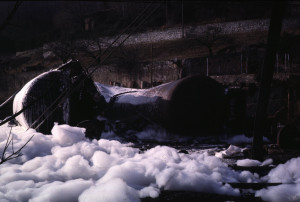A 20-car convoy left a tunnel around 11:30 pm in order to cross a train station when 7 tanks carrying 80 m3 of gasoline derailed. An axle with an overheated roller bearing broke on one of the railcars. Traces on the rail ties and ballast attest to the fact that this car followed the convoy for a distance of 300 m and left the track in the direction of a rail switch 100 m or 150 m ahead of the derailment.
With a shell torn over 1/3 its length and a bottom check valve torn off, 4 of the tanks emptied their contents, a violent fire broke out, and the rail conductor moved the remaining cars out of danger. 15 to 20 minutes later, one of the cars overturned and opened, leading to an explosion and fireball; the heat flux alone burned a dwelling and field located 100 m from the tracks. Streams of burning hydrocarbons (HC) spilled 20 m below onto a street lined with buildings, which served to channel the ignited gasoline; a total of 15 houses and 15 vehicles were destroyed. Cast iron sewer plates were projected some 15 to 20 m high, then a fire and series of explosions destroyed the stormwater pumping station 250 m downstream, preventing pollution from flowing into the Rhone River.
The fire was extinguished during the morning by 250 fire-fighters. Within a 600 m perimeter, 1,000 individuals were evacuated at night; 6 injuries were reported. The conductor and 2 residents sustained skin burns, 3 others suffered fractures and contusions while escaping the flames.
Commissioned by the municipality and rail operator, a consultant assessed the consequences of this accident and monitored the introduction of site safety features: cleaning/inerting of sewers by pumping and ventilation (3,000 m³/h), inventory of access points, inspection of gas contents and collector pipes to eliminate eventual pockets of HC. Then came the pollution cleanup effort: 20 m³ of the remaining HC inside the railcars; 300 m³ lost; 200 m³ burned/evaporated during explosions (either in sewers or after ventilation); and 100 m³ in the soil and water table (from 1 to 4 m deep). Yet municipal water collection further upstream was not compromised.
Within a few hours, 16 piezometers were drilled into place. In 4 days’ time, 110 water samples and 250 “gas” measurements were performed in the soils, on a daily basis for a week, allowed evaluating the pollution. Heat from the fire facilitated degassing of the soil, yet the measurements still indicated a 1-m deep pollution in the embankment underneath the tracks (covering 1.1 ha), as well as subsoil in the urbanised part of the embankment reaching 80 m (1.5 ha). HC contents exceeding a max of 2,500 ppm were recorded in the instruments. A fluvial drain along the embankment drained the floating HC, with a portion being recovered prior to the station. To draw down the water table, 5 wells (1.2 m in diameter) were dug. The zones with persistently abnormal values were to be ventilated and cleaned. Used previously after an accident on this same track in 1990 (ARIA 2438), the selected “venting” technique limits treatment time and costs. To both the north and south of the polluted parcels, 2 networks placed the soils in depression (differential pressure = 250 mbar) and a hydraulic dam completed the set-up on the eastern side. All drained HC were incinerated in 2 mobile furnaces. 98% of the HC was recovered within 4 months, during which time 100 people had to be housed in new accommodations.
According to the rail company, the rehabilitation and compensation costs (for third parties and the municipality) amounted to 11 M (1993 rate), including 2 M to rebuild the station and 2 M on treatment. Shortly thereafter, the company created an entity for the purpose of monitoring the isolated railcars (diffused traffic) and convoys in real time, and providing advice and information in the event of a transport accident to make prudent use of public sector emergency response services.
Whether in transporting hazardous substances or at classified facilities, the potential consequences of a massive uncontrolled spreading of flammable liquids implies an emergency intervention to limit propagation and quickly implement the resources that allow evaluating and treating the pollution. Substantial risks, especially in the case of network spills (covered by the ATEX Directive), need to be incorporated into safety reports and emergency plans.
Beyond the initial response, attention quickly turned to the issue of limiting the extent of subsoil and sewer network pollution by hydrocarbons. The entities present (municipality, rail operator and administrative authorities) had to make decisions, under emergency conditions, to evaluate, without delay, extension of the pollution and the seriousness of actual and potential consequences. They were also faced with implementing measures to prevent the spreading of hydrocarbons, even though responsabilities were not clearly established and the delay and cost of remedial were not available.
Download the detailed report in .pdf format (139 Kb)




